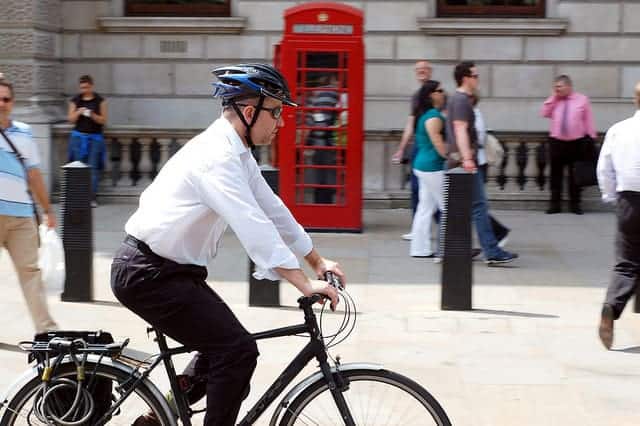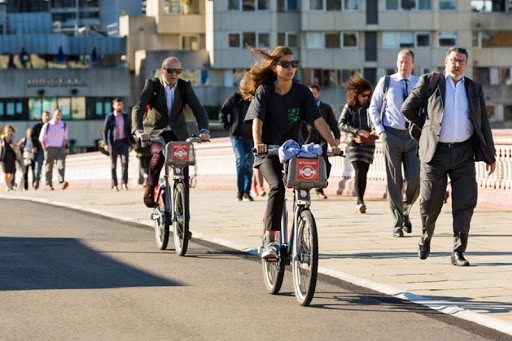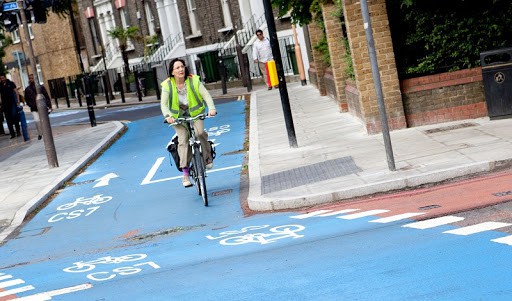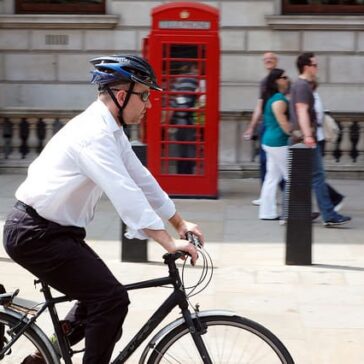
With the ongoing issues around the easing of the COVID 19 lockdown and the likelihood that no one has any urge (if feasible) to use public transport, lots of people will be thinking about the possibility of cycling to work. Public transport will be reduced to just 10% of its capacity and many people may be thinking that they don’t want to go back to their previous car commuting lives. Cycling, although it was previously having a heyday, is most definitely having one during lockdown.
There are plenty of bits of kit you need to get you on the road and cycling. I’ve have gone into this before in a couple of posts here and here.
I’ve also talked about the mental and physical health benefits of cycling to work here.
I’ve been commuting to work by bike for nearly 10 years, and want to look the other aspects of cycling to work you need to take into account before jumping in.
Distance – Is it feasible to cycle?
I would say a 10-mile (one way) commute is feasible, or at least contemplatable, depending on the route. Anything further, you may want to consider an e-bike, which are becoming more affordable and the batteries are getting better and smaller. You can also have fun, kicking regular cyclist’s asses. Link here.
Have you considered it properly? It’s possible very do-able.

Ten years ago, with a 4 mile (one way) commute in Birmingham, I never considered cycling. A move to London and expensive train tickets soon got me jumping on a bike to complete a 10-mile commute (one way).
Cities like London, Manchester or Birmingham need or lend themselves to cycle commuting. If you live in a smaller town or more rural area, you may have not considered cycling as the bus, train or car work for you. Seriously consider the possibility of cycling.
Is there somewhere to lock your bike?
Does your work or somewhere close by have a safe place to lock a bike up? A dedicated bike rack within a site compound or underground car park is best. Is it something your company can find a bit of space for and provide? With limited office occupation, there may be extra space in an office or site?
Are you happy to lock up your pride and joy at work?
If you are looking to buy a new bike or already have a fancy road/gravel or mountain bike, you need to consider this. That £2k bike in the shop looks fantastic, but are you willing to leave it anywhere that’s not inside your house?
Is there somewhere to get showered/changed?
How you are going to ride (speed) answers this question. Or may change how you plan to ride. If the answer is – over 5 miles and you plan to go fast on a road bike; you’ll need a change of clothes, a place to change and possibly a shower. If a changing room or shower is not available – then how can you cycle without them being available? Can you keep it a pace where you’ll not get too hot, or wet, and then pull your work gear on when you arrive.
Can you do it in your civvies?
If it’s less than 5 miles and you plan to go at an easy pace, on a less “fast bike” you could wear your civvies on the bike or wear some of the “urban commuter” gear that lends itself to cycling but can also be worn in an office or socially.
The tops are normally a blend of materials that make the clothing more suited to the activity. The trousers and shorts are hardwearing with some added elasticity, anatomically suited to aid cycling and have strong belt loops and high rear waistlines to conserve your modesty.
Take a look at the Muxu, swrve, Vulpine, Endura and Resolute Bay websites.
Can you have or do you need a gear stash at work?
Having a few bits at work is helpful, one, so you don’t have to carry it every day and two, if you do forget something, like your boxers or knickers you have a spare pair handy.
Below is a list to get you started or thinking-
- Leave your work shoes at work
- Spare emergency pants and socks
- A change of clothes (work shirts etc.)
- Towel
- Shower gel
- Deodorant
- Moisturiser
- Hairbrush
- Makeup
- Wet wipes and dry shampoo (if no showers and you’re okay with this!)
- Extra spare inner tube
Safety?

This is the number one reason (or lack of it) why someone believes that cycling to work is or has not been an option. Three-fifths of adults in the UK feel that it is too dangerous to cycle on the roads (According to the National Travel Survey).
Mile for mile, the chances of being killed whilst cycling are about the same as those for walking, and on average, one cyclist is killed on Britain’s roads for every 29 million miles travelled by cycle. Although, the health benefits gained from cycling far outweigh the life-years lost through injuries by around 20:1.
I feel that with some intentional thought and preparation if safety is an issue for you, it can be remedied slightly. The first point regarding this would be, which route you take.
Consider your route
In the 5 years I’ve been cycling, for where I live now to where I work, I’ve always taken the same route. It’s along a busy road, some of which has a segregated cycle path, and some of which has a narrow painted lane on the side of the road that comes and goes depending on the width of the road. Queuing school traffic, make one section more precarious.
A friend recently told me about a National Cycle Lane that would cover half my journey. I’d seen this lane from the train many times (it runs alongside the train line) but never got around to checking it out. So, I went to check it out, and it’s fantastic. A dedicated cycle lane surrounded by trees and plants, that makes you feel as if you’re in the countryside. This longwinded point is that with a tiny bit of effort and investigation, I could have easily found a more pleasant and safer route to work and so can you.

The cycling infrastructure in the UK is substandard, but it is improving. Some schemes like the one above are great, whilst some around me only create more danger. The government has recently pledged £2 billion package to create a new era for cycling and walking (£250m fast-tracked for pop-up bike lanes) and has also encouraged councils to bring their existing plans forward. Some of this mess is of the governments making. Local authorities have had budget after budget cut via austerity, so I hope this is not another Conservative pledge that disappears like many others have. Maybe, the current situation has made them turn to a solution that has been staring them in the face for years.
My advice regarding routes would be to start with a route planner such as one on the Cycling UK website or Google maps (click the bike button and not the default car button), but other than that, you need to have a really good look about the area your route is on. Look at the side roads, look for cycling route signs. Routes can annoying disappear and then reappear, or a route suddenly forks with no explanation or signage, so you sometimes have to go and figure out where they end up. Don’t just follow the route you would in a car. Are there rivers, parks or canals you can use. Go and check the route on a weekend. Watch where other cyclists go, and follow them. They probably know the short cut!
Do some practice and gain confidence
If you’ve not been out on a bike for some years – have a little practice. Take your bike to a park or to a quieter road to have a practice. Try some hand signalling, therefore riding with one hand, whilst continuing to move and also practice looking over your shoulder (for traffic) but then not veering into the middle of the road. There are also cycle schools where you can brush up on your skills.
Don’t rush
This would be the best piece of safety advice. Is a 20-30 second wait worth having an accident for?
Ride defensively or conservatively. Do not go up the inside of a bus or lorry, an also be careful doing so with cars. Pass through stationary traffic in the middle of the road and at junctions with waiting traffic. Pull into the middle of the lane so you are not pinned against the kerb and can move off easily with the car behind you.
Be wary of doors from parked cars opening into your path and also pedestrians. Some of my near-misses have been with pedestrians stepping out into the road without looking, especially on routes with bike lanes and little car traffic.
Are you going to cycle in the rain?
Under normal circumstances, if it’s raining, the advice would be – don’t bother. It’s just not worth it. Cycling in the rain horrendous and not fun. Your kit from the morning will not be dry by the evening and pulling on wet kit is is not a pleasure.
These are not normal circumstances though, so it’s something to think about. There’s lots of wet weather kit and bags. There are covers to go over you cleats/shoes, water “resistant” shorts and jeans and a multitude of jackets. This does involves buying more and more expensive stuff which you may use less than you think. I will say, in a downpour, it feels like someone’s holding a hose at point-blank range in front of you ! For the less serious road bike lycra wearer, a waterproof jacket, trousers and wellies combo is the best option to keep you dry, although a little cumbersome. Mudguards also make a huge difference.
I don’t want to put you off cycling. Riding in the rain is manageable and you get caught in the rain less than you would think. Those soggy days, make the sunny days, like it currently is, all the more pleasurable.
I hope that’s made you think about some of the ins and outs of cycling to work. With a little prep and effort, it really is worth it. Think about the sunny days, the endorphins, being in control, no trains, no traffic jams, better health, saving the planet, sleeping better and just looking cool on your new bike!




